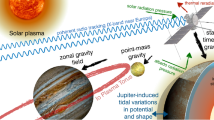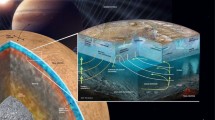Abstract—The results of a three-dimensional numerical simulation of the oblique impacts of ten-kilometer asteroids at an angle of 45° onto a solid surface and into an ocean with a depth of 1 to 6 km are presented. The maximum masses of water, impactor, and soil ejected into the atmosphere and the masses of water, impactor material, and soil remaining in the atmosphere 10 min after the impact are calculated. The mass of vaporized ejecta is determined. It is shown that there are 2–5 times more impactor material and soil ejected into the atmosphere during oblique impacts than during vertical impacts.





Similar content being viewed by others
REFERENCES
Alvarez, L.W., Alvarez, W., Asaro, F., and Michel, H.V., Extraterrestrial cause for the Cretaceous–Tertiary extinction, Science, 1980, vol. 208, no. 4448, pp. 1095–1108.
Artemieva, N. and Morgan, J., Modeling the formation of the K-Pg boundary layer, Icarus, 2009, vol. 201, no. 2, pp. 768–780.
Claeys, Ph., Impact events and the evolution of the Earth, Ch. 9 of Lectures in Astrobiology, Gargaud, M., Martin, H., and Claeys, Ph., Eds., Advances in Astrobiology and Biogeophysics Ser., vol. 2, Berlin: Springer, 2007, pp. 239–280.
Feulner, G., Limits to biodiversity cycles from a unified model of mass−extinction events, Int. J. Astrobiol., 2011, vol. 10, no. 2, pp. 123–129.
Hildebran, A.R., Penfield, G.T., Kring, D.A., Pilkington, M., Camargo Z., A., Jacobsen, S.B., and Boynton, W.V., Chicxulub crater: A possible Cretaceous/Tertiary boundary impact crater on the Yucatán peninsula, Mexico, Geology, 1991, vol. 19, no. 9, pp. 867–871.
Kring, D.A., The Chicxulub impact event and its environmental consequences at the Cretaceous–Tertiary boundary, Palaeogeogr., Palaeoclimatol., Palaeoecol., 2007, vol. 255, nos. 1–2, pp. 4–21.
Kuznetsov, N.M., Termodinamicheskie funktsii i udarnye adiabaty vozdukha pri vysokikh temperaturakh (Thermodynamic Functions and Shock Adiabats for Air at High Temperatures), Moscow: Mashinostroenie, 1965.
Pierazzo, E., Garsia, R.R., Kinnison, D.E., Marsh, D.R., Lee-Taylor, J., and Crutzen, P.J., Ozone perturbation from medium-size asteroid impacts in the ocean, Earth Planet. Sci. Lett., 2012, vol. 229, nos. 3–4, pp. 263–272.
Rampino, M.R., Relationship between impact-crater size and severity of related extinction episodes, Earth-Sci. Rev., 2020, vol. 201, Article ID 102990.
Shuvalov, V.V., Multi-dimensional hydrodynamic code SOVA for interfacial flows: Application to thermal layer effect, Shock Waves, 1999, vol. 9, no. 6, pp. 381–390.
Shuvalov, V.V., Release of matter into the atmosphere during the fall of ten-kilometer asteroids into the ocean, Sol. Syst. Res., 2021, vol. 55, no. 2, pp. 97–105.
Shuvalov, V. and Dypvik, H., Ejecta formation and crater development of the Mjølnir impact, Meteorit. Planet. Sci., 2004, vol. 39, no. 3, pp. 467–479.
Shuvalov, V.V. and Khazins, V.M., Numerical simulation of ionospheric disturbances generated by the Chelyabinsk and Tunguska space body impacts, Sol. Syst. Res., 2018, vol. 52, no. 2, pp. 129–138.
Thompson, S.L. and Lauson, H.S., Improvements in the Chart D Radiation-Hydrodynamic CODE III: Revised Analytic Equations of State, Report SC-RR-71 0714, Albuquerque: Sandia National Laboratory, 1972.
Wünnemann, K. and Ivanov, B.A., Numerical modeling of the impact crater depth-diameter dependence in an acoustically fluidized target, Planet. Space Sci., 2003, vol. 51, no. 13, pp. 831–845.
ACKNOWLEDGMENTS
I thank the reviewers B.A. Ivanov and M.V. Gerasimov for carefully reading the paper and providing valuable comments and advice.
Funding
The study was carried out as part of the state assignment to the Institute of Geosphere Dynamics of the Russian Academy of Sciences (reg. no. 122032900176-3).
Author information
Authors and Affiliations
Corresponding author
Ethics declarations
The author declares that he has no conflicts of interest.
Rights and permissions
About this article
Cite this article
Shuvalov, V.V. Numerical Simulation of Material Ejection into the Atmosphere Induced by Oblique Impacts of Ten-Kilometer-Diameter Asteroids into the Ocean. Izv., Phys. Solid Earth 59, 452–459 (2023). https://doi.org/10.1134/S1069351323030126
Received:
Revised:
Accepted:
Published:
Issue Date:
DOI: https://doi.org/10.1134/S1069351323030126




